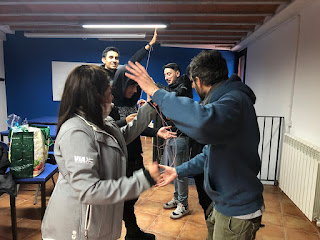One week ago, new international students arrived in our university to stay for a semester. Is always good to arrive in a city that you don't know and go for a ride with someone that can explain the history of this new place that you're visiting.
Thats was exactly what we did on Sunday, 12nd of February, we did a guided bike ride through Barcelona.
 At 9h30min AM we meet everybody in the Born neighbourhood, where we could rent a bike and meet out guide, the Architect Jaume Carné.
At 9h30min AM we meet everybody in the Born neighbourhood, where we could rent a bike and meet out guide, the Architect Jaume Carné.
Around 10AM, everyone already had their bikes regulated, all tires are full of air and the lazy of Sunday's was out of our body in this morning.
The first stop was in the monument of Colom, where we start to know a little bit of the history of Barcelona. Jaume start to teach us about the romans, the wars, the old city of Barcelona and about the small villages that were not integrated in the city, like Grácia, Sant Andreu and La Sagrera.
After a quickly panorama of the history, we take our bikes and ride through Parallell Avenue until arrive in the heart of one of the patios of the Example. In this stop we stayed for a while, because now Jaume told us about all the urbanism plan, made by the Catalan engineer Ildefons Cerdà.

 His plan was to unify all the small village around Barcelona with the center of the city. In the 1850's the city wall strait-jacket was demolished to allow the expansion of Ildefons Cerdà's l'Eixample. Cerdà's plan was the first example of urban planning and was heavily influenced by the ideas of Karl Marx and other social thinkers of the time.
His plan was to unify all the small village around Barcelona with the center of the city. In the 1850's the city wall strait-jacket was demolished to allow the expansion of Ildefons Cerdà's l'Eixample. Cerdà's plan was the first example of urban planning and was heavily influenced by the ideas of Karl Marx and other social thinkers of the time.
The l'Eixample was planned using an extensive grid-iron pattern. The development rapidly spread to connect Barcelona to the outlying towns, which were incorporated into the city at the turn of the century.
The area of Gracia, for example, was Spain's nineth-largest city before it was swallowed by Barcelona's growth. The rigid blocks of Cerdà's grid give way here to narrow streets arranged haphazardly, and the change in atmosphere is striking. Many streets in Gracia consist of small, two-storey buildings, and a series of small squares.
Around 2PM, we already had visited the most important patios, heard the important facts of the history and out new students already had an idea about the city, that why we stopped in some bar to take a beer and eat the spanish traditional omelet, tortillas !





No comments:
Post a Comment